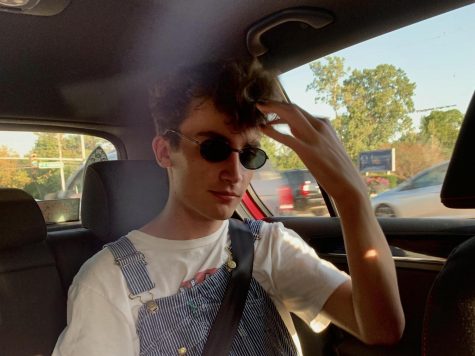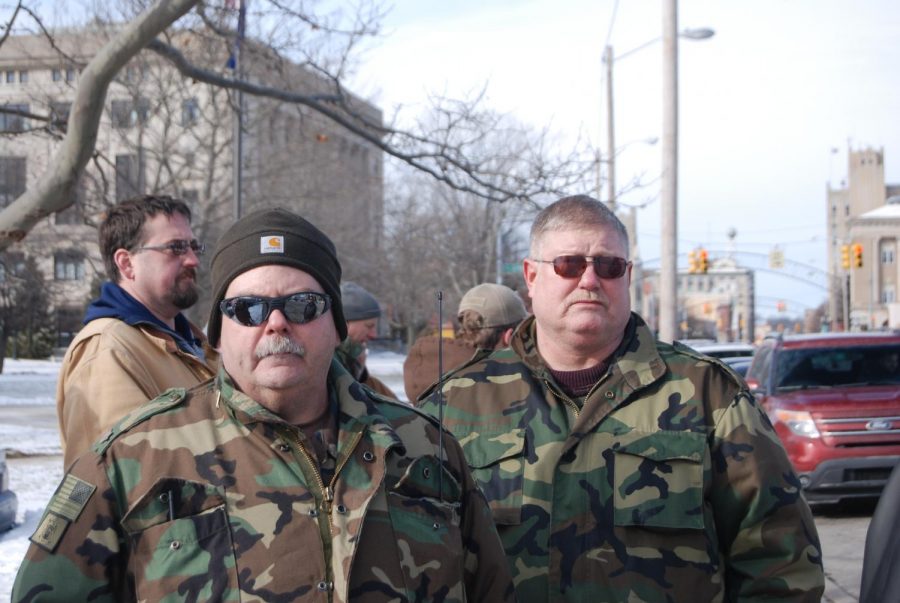The bridge
Counter-protesters in Flint, MI. Across the street, the larger protest was against President Trump’s immigration policy.
As the winter of my freshman year waned, the stir of a crowded protest suffocated me. Light streamed through a wall of windows; soft and cloudy, it seemed to penetrate every corner of Flint’s University Pavilion. My grandpa’s camera bounced on my chest. My dad smiled at me as I skirted along the wall.
Looking for my first interview, I scanned the crowd for a friendly face, or even better, a familiar one; I hoped for a safe place to start. But as I finally approached a lone man on a barstool, my opening sentence doing backflips around my head (“Hi, my name is Isaac McKenna and I’m a journalist for my school’s publication…”), he stood and left me swaying, disoriented.
I quickly readjusted, choosing the least intimidating person in sight: a short man in a winter hat reading “FLINT.” My line tumbled out rapid-fire: “Would you be willing to answer a few questions for me?”
He brought me back to the table where his husband sat, wearing a matching outfit and holding a sign with #NoWalls and #Muslimbanprotest written in black marker. My relief at their willingness to talk withered as I tried to remember everything I needed to do. Press record, practice active listening, ask about their backgrounds, dive deep, and always get the spelling of their names.
Ten minutes later, I thanked them, hands steady now as I ended the recording and titled it “Gilbert and Jey Hall.” My work done, my apprehension assuaged, I snapped a last photo as I walked towards my dad. But he was turned away from me, looking through the wall of glass at the street as a muffled roar began to rise.
The shouts were much louder once we had made our way outside, and the change in atmosphere was tangible. Dodging through bodies to the edge of the sidewalk, I looked across the street to see ten burly white men holding a “Don’t Tread on Me” banner. With fatigues and sunglasses, they presented an inherent challenge to the crowd that had gathered. But the wide road was a river too dangerous to cross — neither group dared to do more than posture on their respective banks, across swirling depths.
Fully zoomed, I took a few photos, which ended up blurry on the camera’s tiny screen. I opened a note on my phone to record my impressions of the drama, but it stayed blank. Noticing a crosswalk to my left, I turned to my dad.
“I think I’m going to go talk to them.”
With my dad’s slightly incredulous encouragement like a life jacket, I approached the cracked white paint of the crosswalk, a rickety bridge. My hands shook as I stepped from the edge of the sidewalk, my toes finding the edges of cracks, my head down. On the other side of the street, I looked at the men as if down a tunnel.
Only then did I notice the guns. Every step of my shaky protocol left my head, replaced with images of AR-15s slung around shoulders, handguns tucked into waistband holsters. My sneakers scuffed the ground as my pace slowed from nervous speed to terrified crawl.
And yet I walked — carried by the article I needed to write, by the need to include these men’s voices. A few steps away, their stony, mustached faces registered my approach. My throat felt closed, my dad far away.
But I realized that in that moment I was not a part of the crowd across that raging river. My voice, despite my youth, had power; my writing could be a catalyst for change. I was objective, curious, and brave: I was not lost — I was the bridge. And I found the resolve for the most important piece of my plan.
“Hi, my name is Isaac McKenna, could I have a minute of your time?”




